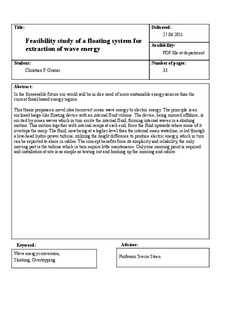| dc.contributor.author | Grøner, Christian Fredrik | nb_NO |
| dc.date.accessioned | 2014-12-19T12:06:39Z | |
| dc.date.available | 2014-12-19T12:06:39Z | |
| dc.date.created | 2012-02-08 | nb_NO |
| dc.date.issued | 2011 | nb_NO |
| dc.identifier | 492872 | nb_NO |
| dc.identifier.uri | http://hdl.handle.net/11250/237966 | |
| dc.description.abstract | The idea of harnessing energy from the ocean waves is a seductive one, a limitless resource. But the road from idea to success is long and has been traveled by many, the great achievements are few and far between.
This thesis proposes a novel idea to convert ocean wave energy to electric energy. The principle is an enclosed barge-like floating device with an internal fluid volume. The device, being moored offshore, is excited by ocean waves which in turn excite the internal fluid, forming internal waves in a sloshing motion. This motion together with internal ramps at each end, force the fluid upwards where some of it overtops the ramp. The fluid, now being at a higher level than the internal mean waterline, is led through a low-head hydro-power turbine, utilizing the height difference to produce electric energy, which in turn can be exported to shore in cables. The concept benefits from its simplicity and reliability, the only moving part is the turbine which in turn require little maintenance. Only one mooring point is required and installation at site is as simple as towing out and hooking up the mooring and cables.
A numerical model was set up on the basis of ocean wave data at a position offshore west of the Norwegian shore. The results showed promise of an increase in the tanks free surface elevations at the end of the ramps, an increase which was a small magnitude larger than the incoming waves for a wide band of wave periods.
A model was built based on the geometrical model used in the numerical testing. Model testing was performed in a wave basin to provide the physical data needed to get information of the non-linear sloshing this concept relies on.
Results turned out to be dubious, but some few test data showed promise of the idea being interesting. There is an obvious need for more testing, with greater accuracy in both the numerical models and the physical test models. | nb_NO |
| dc.language | eng | nb_NO |
| dc.publisher | Norges teknisk-naturvitenskapelige universitet, Fakultet for ingeniørvitenskap og teknologi, Institutt for marin teknikk | nb_NO |
| dc.title | Feasibility study of a floating system for extraction of wave energy | nb_NO |
| dc.type | Master thesis | nb_NO |
| dc.contributor.department | Norges teknisk-naturvitenskapelige universitet, Fakultet for ingeniørvitenskap og teknologi, Institutt for marin teknikk | nb_NO |
